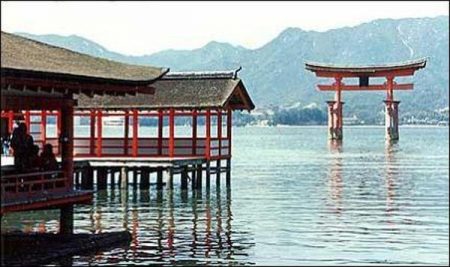The southern part of Japan was not only a more productive environment but also in closer contact with that part of mainland Asia in which Chinese culture was expanding and maturing during the late feudal era. Refugees from China, during the final bitter struggles of feudalism and the appearance of the Han state, carried Chinese culture into Korea and brought it into range of southern Japan, whose peoples were themselves in contact with Korea.
These contacts can be traced to at least the third century B.C., and they gradually raised the culture level of southern Japan out of the Stone Age, though central and northern Japan lagged behind. The peoples of southern Japan were grouped in matriarchal tribal and clan patterns, each occupying small coastal sections. A competitive situation developed among these local groups, with the Yamato of Kyushu gaining the ascendancy and moving their headquarters to the eastern end of the Inland Sea by about A.D. 300. There was a general eastward movement of tribes and clans, including immigration from Korea and perhaps from the China coast.
Though the precise racial and cultural origins are not clear, rice culture, horses, cattle, the pig, and the dog appeared in southern Japan during these centuries. The horse came with the cavalry-warrior complex and was taken up by clan leaders and tribal chiefs as a means of solidifying their regional and group controls. Rice culture brought with it other crops, agricultural practices, and domestic use techniques. Metallurgy, domestic architecture, village settlement, and social patterns, all filtered in slowly.
Many of these items came from China but not all from the North China culture hearth, some coming undoubtedly from the Yangtze Delta and coastal country, and others from Manchuria and the Mongolias. A few features may have come from South China, from the same centers that had spread many culture traits southward into southeastern Asia, but it is doubtful if much of Japanese direct cultural origins lie as far afield as southeastern Asia.
Kyushu, Shikoku, and the portion of Honshu fronting on the Inland Sea were the regions in which both human and culture migrations occurred. Water movement and fishing economies remained strong, mixing peoples and the details of culture. Replacement of primitive practices occurred, and new ideas were blended into old ones. Population grew, and most of the lowland alluvial tracts were settled. This whole process of development was restricted to southern Japan, and gradually there came to be marked differences between this southern region and the areas north of the Inland Sea.
In the north country the Ainu and possibly other Stone Age peoples were thinly scattered and culturally undeveloped. As time passed the contrast became greater, and, as the southern peoples more and more fully occupied their lowlands, local pressures for space began to develop. Slowly the southern peoples began moving into the edges of their own upland regions and also pushing northward along the lowland fringes of Honshu. This southern section, therefore, as the culturally advanced region, became the source for the colonizing of the rest of the Japanese islands and the local source of the cultural patterns that gradually have grown into modern Japanese civilization.
Visits: 109



